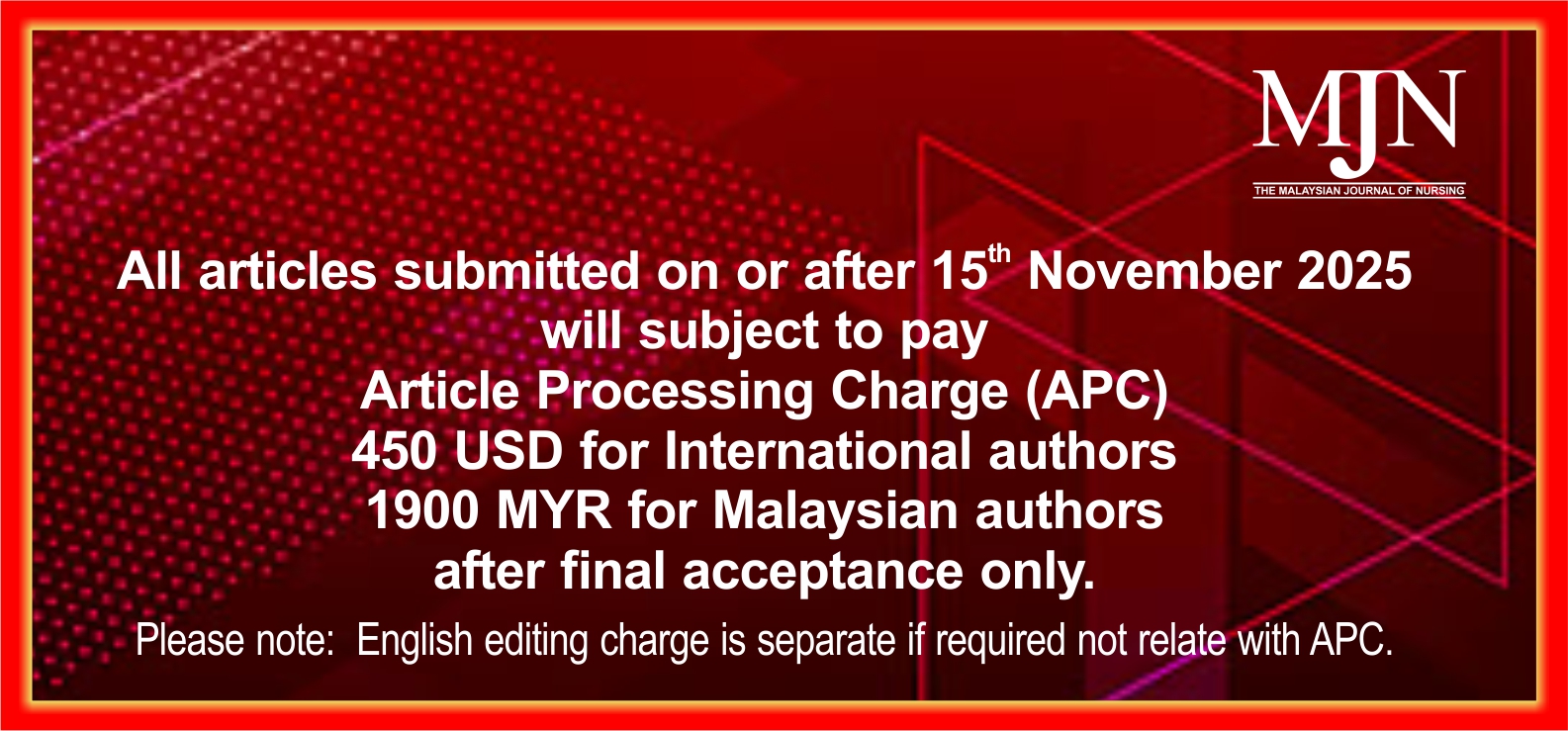Burnout among Nurses in Critical Care Units: Addressing a Persistent Challenge
DOI:
https://doi.org/10.31674/mjn.2024.v16i02.010Abstract
Background: Burnout is a highly prevalent occupational disease among nurses, especially those working in complex critical care settings. Objective: To determine the level of burnout among nurses practicing in critical care units. Methods: This study employed a descriptive cross-sectional design, involving 377 nurses working in critical care units across 13 hospitals in Iraq. Data were collected using sociodemographic, professional characteristics of the nursing competency and performance, and the Burnout Assessment Tool. The data was analysed using descriptive statistics. Results: The study showed a high prevalence of overall burnout among nurses, with a mean score of 2.53. The study also revealed medium levels of mental detachment, cognitive impairment, emotional impairment, and psychological distress, with mean scores of 2.18, 1.85, 2.17, and 2.71, respectively. The exhaustion and psychosomatic complaints scored highly, with mean scores of 3.07 and 2.87, respectively. Conclusion: Nurses in critical care units experienced a high level of burnout. Within the dimensions of burnout, high levels of exhaustion and psychosomatic complaints were found, as were medium levels for each of the dimensions of mental distance, cognitive impairment, emotional impairment, and psychological distress.
Keywords:
Burnout, Nurses, Intensive Care UnitsDownloads
References
Abdulnabi, Z. A., & AL-Fayyadh, S. (2021). Barriers of professional autonomy among arab-speaking countries during covid-19 pandemic. Journal of Contemporary Medical Sciences, 7(3), 158–163. https://doi.org/10.22317/jcms.v7i3.1004
Alkhawaldeh, J. F. M. A., Soh, K. L., Mukhtar, F. B. M., & Ooi, C. P. (2020). Effectiveness of stress management interventional programme on occupational stress for nurses: A systematic review. Journal of Nursing Management, 28(2), 209–220. https://doi.org/10.1111/jonm.12938
Al-Rjoub, S. F., Diener, E., & Sadeq, A. F. (2022). Nurse administrators as the cause of moral distress among nurse educators: A qualitative research study. Journal of Professional Nursing, 43, 117-123. https://doi.org/10.1016/j.profnurs.2022.09.007
Alzahrani, H. M., Alanazi, E. F., & Almutairi, S. M. (2024). Burnout among nurses in intensive care unit in Saudi Arabia: Implications for nursing management. British Journal of Nursing Studies, 4(2), 01-09. https://doi.org/10.32996/bjns.2024.4.2.1
Ashipala, D. O., & Nghole, T. M. (2022). Factors contributing to burnout among nurses at a district hospital in Namibia: A qualitative perspective of nurses. Journal of Nursing Management, 30(7), 2982-2991. https://doi.org/10.1111/jonm.13693
Barnard, N. B., Rothmann, S., De Beer, L. T., & Lubbe, W. (2023). Burnout of emergency nurses in a South African context: The role of job demands and resources, and capabilities. Frontiers in Psychology, 14, https://doi.org/10.3389/fpsyg.2023.1119063
Basinska, B. A., Gruszczynska, E., & Schaufeli, W. B. (2023). The Polish adaptation of the Burnout Assessment Tool (BAT-PL) by Schaufeli et al. Psychiatria Polska, 57(1), 223-235. https://doi.org/10.12740/pp/onlinefirst/141563
Browning, S. G. (2019). Burnout in critical care nurses. Critical Care Nursing Clinics, 31(4), 527-536. https://doi.org/10.1016/j.cnc.2019.07.008
Bruyneel, A., Smith, P., Tack, J., & Pirson, M. (2021). Prevalence of burnout risk and factors associated with burnout risk among ICU nurses during the COVID-19 outbreak in French speaking Belgium. Intensive and Critical Care Nursing, 65. https://doi.org/10.1016/j.iccn.2021.103059
Cishahayo, E., Nankundwa, E., Sego, R., Bhengu, B., & Cishahayo, E. U. (2017). Burnout among nurses working in critical care settings: a case of a selected tertiary hospital in Rwanda. International Journal of Research in Medical Sciences, 5(12), 5121-5128. http://dx.doi.org/10.18203/2320-6012.ijrms20175430
Clark, K., Milner, K. A., Beck, M., & Mason, V. (2016). Measuring family satisfaction with care delivered in the intensive care unit. Critical Care Nurse, 36(6), e8-e14. https://doi.org/10.4037/ccn2016276
Dadoosh, K. A., & Sadeq, A. F. (2022). Compassion fatigue among nursing staff practicing at neurological wards. Res Militaris, 12(2), 4614-4623. https://efaidnbmnnnibpcajpcglclefindmkaj/https://resmilitaris.net/uploads/paper/44eed2577682f2ea4dc600c89c5d71b6.pdf . Accessed on 26th January, 2024.
de Looff, P., Nijman, H., Didden, R., & Embregts, P. (2018). Burnout symptoms in forensic psychiatric nurses and their associations with personality, emotional intelligence and client aggression: A cross‐sectional study. Journal of Psychiatric and Mental Health Nursing, 25(8), 506-516. https://doi.org/10.1111/jpm.12496
Dijxhoorn, A. F. Q., Brom, L., van der Linden, Y. M., Leget, C., & Raijmakers, N. J. (2021). Healthcare professionals’ work-related stress in palliative care: a cross-sectional survey. Journal of Pain and Symptom Management, 62(3), e38-e45. https://doi.org/10.1016/j.jpainsymman.2021.04.004
Hamad, Z., & Qassim, W. (2019). Effectiveness of an educational program in enhancing nurses’ knowledge about occupational health hazards. Iraqi National Journal of Nursing Specialties, 32(2), 11-18. https://doi.org/10.58897/injns.v32i2.331
Jabar, M. T., & Jasim, A. H. (2021). Job stress among nurses at critical care units in medical city complex hospitals in Baghdad city. Annals of The Romanian Society for Cell Biology, 25(6), 4132-4138. http://annalsofrscb.ro/index.php/journal/article/view/6203. Accessed on 24th December, 2023.
Kadhim, H., & Qassem, W. J. (2023). Impact of physical work environment upon nurses’ job performance in al-nassiryah city hospitals. Iraqi National Journal of Nursing Specialties, 36(1), 16-25. https://doi.org/10.58897/injns.v36i1.707
Khatatbeh, H., Pakai, A., Al‐Dwaikat, T., Onchonga, D., Amer, F., Prémusz, V., & Oláh, A. (2022). Nurses’ burnout and quality of life: A systematic review and critical analysis of measures used. Nursing Open, 9(3), 1564-1574. https://doi.org/10.1002/nop2.936
Konstantinou, A. K., Bonotis, K., Sokratous, M., Siokas, V., & Dardiotis, E. (2018). Burnout evaluation and potential predictors in a Greek cohort of mental health nurses. Archives of Psychiatric Nursing, 32(3), 449-456. https://doi.org/10.1016/j.apnu.2018.01.002
Kowalczuk, K., Krajewska-Kułak, E., & Sobolewski, M. (2020). The effect of subjective perception of work in relation to occupational and demographic factors on the mental health of polish nurses. Frontiers in Psychiatry, 11. https://doi.org/10.3389/fpsyt.2020.591957
Kumar, A., Sinha, A., Varma, J. R., Prabhakaran, A. M., Phatak, A. G., & Nimbalkar, S. M. (2021). Burnout and its correlates among nursing staff of intensive care units at a tertiary care center. Journal of Family Medicine and Primary Care, 10(1), 443-448. https://doi.org/10.4103/jfmpc.jfmpc_1651_20
Kyei, E., & Takyi, S. A. (2024). Burnout, Associated Determinants and Effects among Nurses and Midwives at Selected CHAG Facilities in the Greater Accra Region, Ghana, Research Square. PREPRINT (Version 1). http://dx.doi.org/10.21203/rs.3.rs-3847310/v1
Lewandowska, K., Weisbrot, M., Cieloszyk, A., Mędrzycka-Dąbrowska, W., Krupa, S., & Ozga, D. (2020). Impact of alarm fatigue on the work of nurses in an intensive care environment—a systematic review. International Journal of Environmental Research and Public Health, 17(22), 8409. https://doi.org/10.3390/ijerph17228409
Mansour, H. K., & Hussien, H. A. (2020). Occupational burnout among nurses working at governmental teaching hospitals in Babylon province, Iraq. International Journal of Psychosocial Rehabilitation, 24(04). http://dx.doi.org/10.37200/IJPR/V24I4/PR2020543
Meneguin, S., Ignácio, I., Pollo, C. F., Honório, H. M., Patini, M. S. G., & de Oliveira, C. (2023). Burnout and quality of life in nursing staff during the COVID-19 pandemic. BMC Nursing, 22(1). https://doi.org/10.1186/s12912-022-01168-7
Mohammed, D., & Bakey, S. (2021). Detection of depression among Nurses Providing Care for Patients with COVID-19 at Baqubah Teaching Hospital. Iraqi National Journal of Nursing Specialties, 34(1), 86-94. https://doi.org/10.58897/injns.v34i1.464
Mudallal, R. H., Othman, W. A. M., & Al Hassan, N. F. (2017). Nurses’ burnout: the influence of leader empowering behaviors, work conditions, and demographic traits. INQUIRY: The Journal of Health Care Organization, Provision, and Financing, 54, https://doi.org/10.1177/0046958017724944
Nantsupawat, A., Kunaviktikul, W., Nantsupawat, R., Wichaikhum, O. A., Thienthong, H., & Poghosyan, L. (2017). Effects of nurse work environment on job dissatisfaction, burnout, intention to leave. International Nursing Review, 64(1), 91-98. https://doi.org/10.1111/inr.12342
Palvimo, T., Vauhkonen, A., & Hult, M. (2023). The associations among destructive leadership, job demands and resources, and burnout among nurses: A cross‐sectional survey study. Journal of Nursing Management, 2023(1), https://doi.org/10.1155/2023/4289450
Preetam K, V. (2023). Burnout Syndrome among Nurses in Intensive Care Unit: An Essential Approach. Asian Journal of Research in Nursing and Health, 6(1), 337-342. http://eprints.go2submission.com/id/eprint/1880/1/Nikita612023AJRNH103611.pdf . Accessed on 20th November, 2023.
Rajih, Q. (2020). Effectiveness of an education program on nursing staffs' knowledge about infection control measures at intensive care unit in al-diwaniya teaching hospital. Iraqi National Journal of Nursing Specialties, 33(1), 85-92. https://doi.org/10.58897/injns.v33i1.406
Ribeiro, E. K. D. A., Santos, R. C. D., Araújo-Monteiro, G. K. N. D., Brandão, B. M. L. D. S., Silva, J. C. D., & Souto, R. Q. (2021). Influence of burnout syndrome on the quality of life of nursing professionals: Quantitative study. Revista Brasileira De Enfermagem, 74(Suppl 3). https://doi.org/10.1590/0034-7167-2020-0298
Rudman, A., Arborelius, L., Dahlgren, A., Finnes, A., & Gustavsson, P. (2020). Consequences of early career nurse burnout: A prospective long-term follow-up on cognitive functions, depressive symptoms, and insomnia. EClinical Medicine, 27. https://doi.org/10.1016/j.eclinm.2020.100565
Saravanabavan, L., Sivakumar, M. N., & Hisham, M. (2019). Stress and burnout among intensive care unit healthcare professionals in an Indian tertiary care hospital. Indian Journal of Critical Care Medicine, 23(10). 462–466. https://doi.org/10.5005%2Fjp-journals-10071-23265
Schaufeli, W. B., Desart, S., & De Witte, H. (2020). Burnout Assessment Tool (BAT)—development, validity, and reliability. International Journal of Environmental Research and Public Health, 17(24). https://doi.org/10.3390/ijerph17249495
Schwarz, G. M., & Bouckenooghe, D. (2021). When the dodo became extinct: Why rethinking change should not take a pandemic. The Journal of Applied Behavioral Science, 57(1), 5-10. https://doi.org/10.1177/0021886320973809
See, K. C., Zhao, M. Y., Nakataki, E., Chittawatanarat, K., Fang, W. F., Faruq, M. O., ... & SABA. Study investigators and the Asian critical care clinical trials group. (2018). Professional burnout among physicians and nurses in Asian intensive care units: A multinational survey. Intensive Care Medicine, 44, 2079-2090. https://doi.org/10.1007/s00134-018-5432-1
Shafran Tikva, S., Gabay, G., Shkoler, O., & Kagan, I. (2024). Association of quality of nursing care with violence load, burnout, and listening climate. Israel Journal of Health Policy Research, 13(1), 22. http://dx.doi.org/10.1186/s13584-024-00601-3
Shah, M. K., Gandrakota, N., Cimiotti, J. P., Ghose, N., Moore, M., & Ali, M. K. (2021). Prevalence of and factors associated with nurse burnout in the US. JAMA Network Open, 4(2). https://doi.org/10.1001/jamanetworkopen.2020.36469
Singh, G. (2022). Essential Emergency Critical Care (EECC) related research articles: A literature review. Malaysian Journal of Medical Research (MJMR), 6(3), 55-57. https://doi.org/10.31674/mjmr.2022.v6i03.007
Terry, C. L., & Weaver, A. L. (2011). Critical Care Nursing Demystified. McGraw Hill Medical, New York, United States. https://www.stikeskeluargabunda.ac.id/app_other/file/buku/materi_1617587989.pdf . Accessed on 22nd January, 2024.
Torre, M., Popper, M. S., & Bergesio, A. (2019). Burnout prevalence in intensive care nurses in Argentina. Enfermería Intensiva (English ed.), 30(3), 108-115. https://doi.org/10.1016/j.enfie.2018.04.005
van den Boogert, F., Spaan, P., Sizoo, B., Bouman, Y. H., Hoogendijk, W. J., & Roza, S. J. (2022). Sensory processing, perceived stress and burnout symptoms in a working population during the COVID-19 crisis. International Journal of Environmental Research and Public Health, 19(4), 2043. https://doi.org/10.3390/ijerph19042043
Whittaker, B. A., Gillum, D. R., & Kelly, J. M. (2018). Burnout, moral distress, and job turnover in critical care nurses. International Journal of Studies in Nursing, 3(3). https://doi.org/10.20849/ijsn.v3i3.516
Woo, T., Ho, R., Tang, A., & Tam, W. (2020). Global prevalence of burnout symptoms among nurses: A systematic review and meta-analysis. Journal of Psychiatric Research, 123, 9-20. https://doi.org/10.1016/j.jpsychires.2019.12.015
World Health Organization. (2019). International Classification of Diseases. Burn-out an occupational phenomenon. https://www.who.int/mental_health/evidence/burn-out/en/ . Accessed on 29th January, 2024.
Yanto, R. F., Djudiyah, D., & Syakarofath, N. A. (2022). Nurses’ experience with burnout and therole of perceived social support. Jurnal Ilmiah Psikologi Terapan, 10(1), 63-67. https://doi.org/10.22219/jipt.v10i1.18483
Yusoff, M. S. B. (2019). ABC of content validation and content validity index calculation. Education in Medicine Journal, 11(2), 49-54. https://doi.org/10.21315/eimj2019.11.2.6
Published
How to Cite
Issue
Section
License
Copyright (c) 2024 The Malaysian Journal of Nursing (MJN)

This work is licensed under a Creative Commons Attribution-NonCommercial-NoDerivatives 4.0 International License.



































